Tesco's Approach to People Management: Theories and Practices Explored
VerifiedAdded on 2020/01/21
|15
|4554
|2405
Report
AI Summary
This report examines the crucial aspects of managing people within an organization, using Tesco as a case study. It delves into various motivation theories, including Maslow's Hierarchy of Needs, Herzberg's Two-Factor Theory, and Adams' Equity Theory, analyzing their application, advantages, and disadvantages within the company. The report also explores different leadership styles, such as directive, authoritative, strategic, and cross-cultural leadership, and recommends the most effective approaches for Tesco's diverse workforce. Furthermore, it investigates the characteristics of effective teamwork, emphasizing commitment, participation, and conflict resolution. Through this analysis, the report aims to develop the skills and knowledge necessary for successful people management in an organizational context, providing valuable insights into Tesco's practices and offering recommendations for improvement.
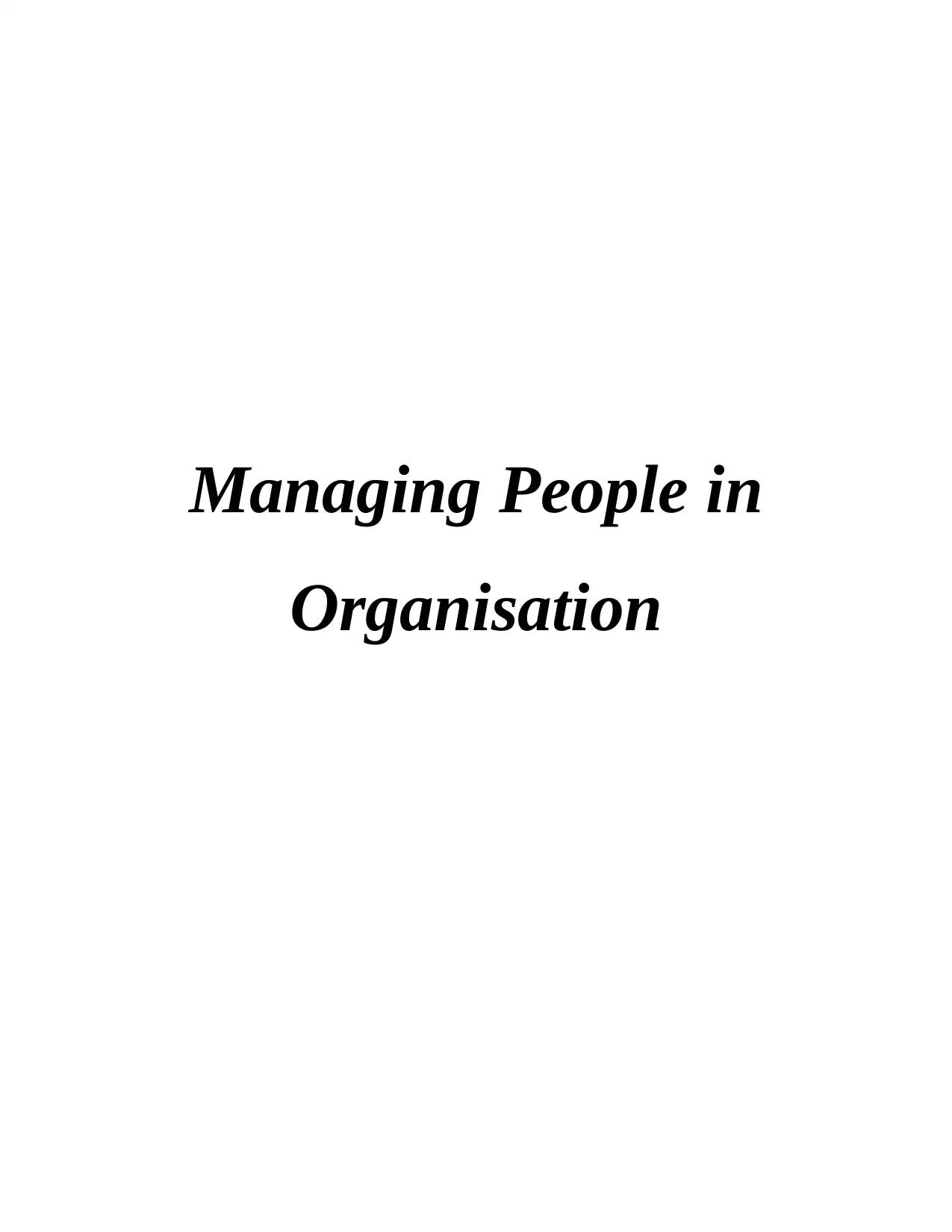
Managing People in
Organisation
Organisation
Paraphrase This Document
Need a fresh take? Get an instant paraphrase of this document with our AI Paraphraser
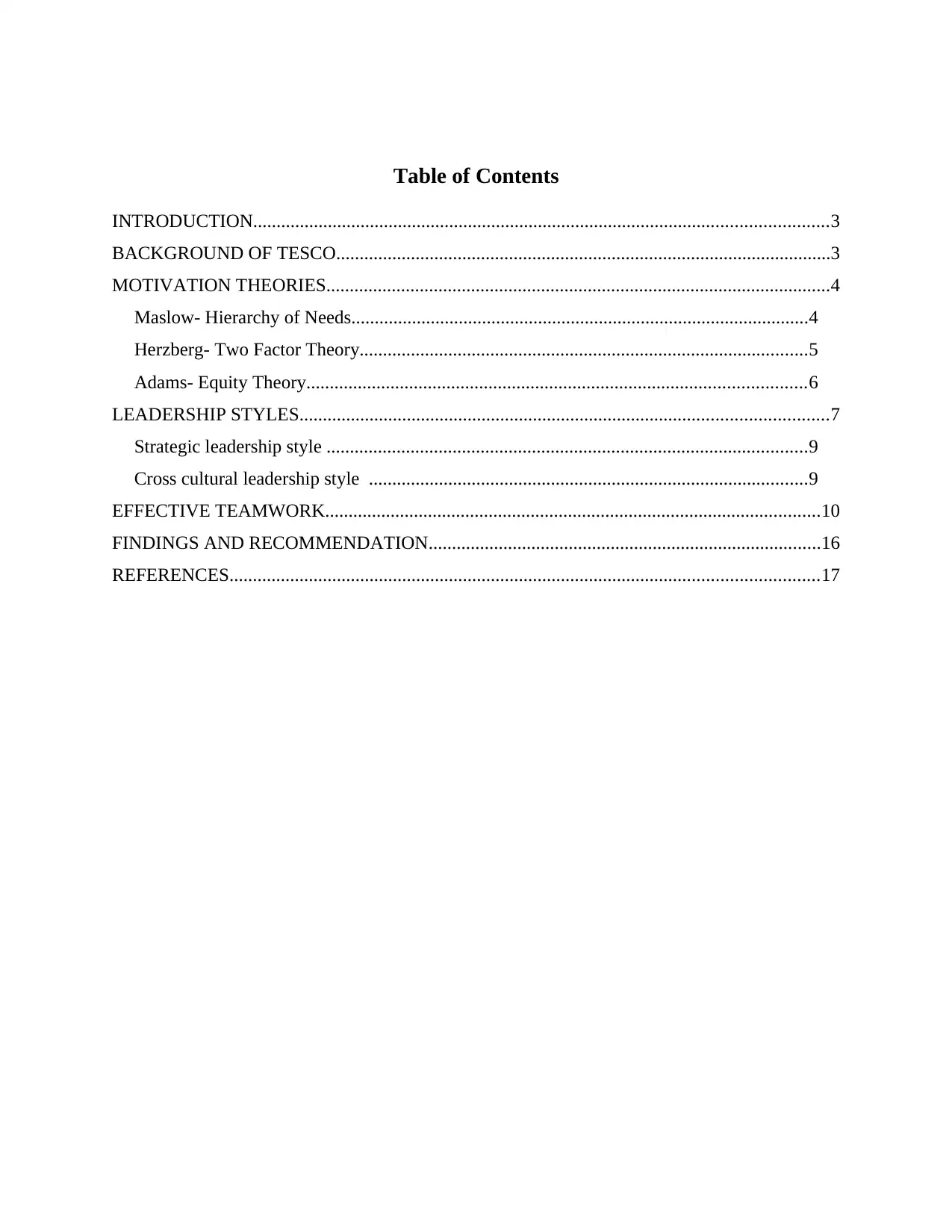
Table of Contents
INTRODUCTION...........................................................................................................................3
BACKGROUND OF TESCO..........................................................................................................3
MOTIVATION THEORIES............................................................................................................4
Maslow- Hierarchy of Needs..................................................................................................4
Herzberg- Two Factor Theory................................................................................................5
Adams- Equity Theory...........................................................................................................6
LEADERSHIP STYLES.................................................................................................................7
Strategic leadership style .......................................................................................................9
Cross cultural leadership style ..............................................................................................9
EFFECTIVE TEAMWORK..........................................................................................................10
FINDINGS AND RECOMMENDATION....................................................................................16
REFERENCES..............................................................................................................................17
INTRODUCTION...........................................................................................................................3
BACKGROUND OF TESCO..........................................................................................................3
MOTIVATION THEORIES............................................................................................................4
Maslow- Hierarchy of Needs..................................................................................................4
Herzberg- Two Factor Theory................................................................................................5
Adams- Equity Theory...........................................................................................................6
LEADERSHIP STYLES.................................................................................................................7
Strategic leadership style .......................................................................................................9
Cross cultural leadership style ..............................................................................................9
EFFECTIVE TEAMWORK..........................................................................................................10
FINDINGS AND RECOMMENDATION....................................................................................16
REFERENCES..............................................................................................................................17
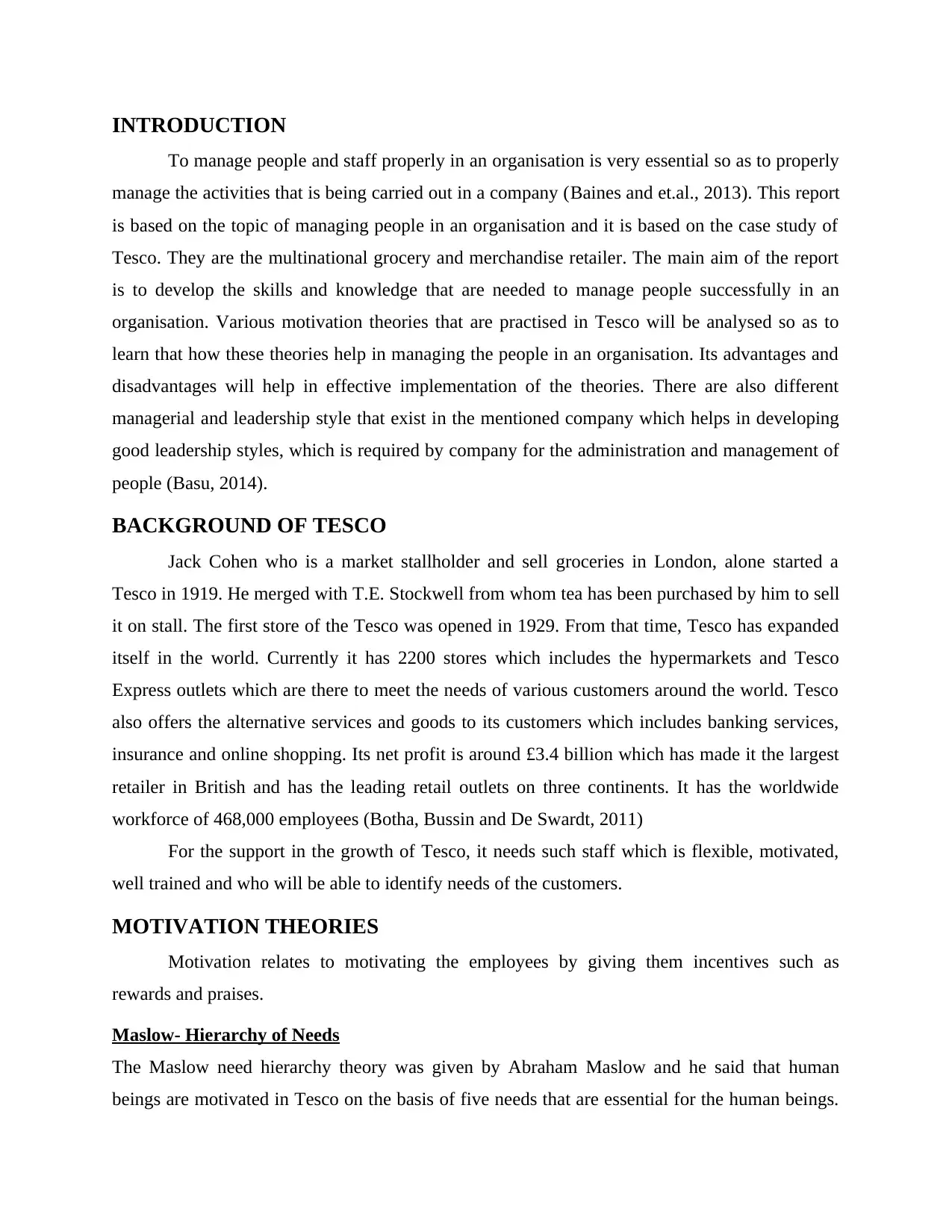
INTRODUCTION
To manage people and staff properly in an organisation is very essential so as to properly
manage the activities that is being carried out in a company (Baines and et.al., 2013). This report
is based on the topic of managing people in an organisation and it is based on the case study of
Tesco. They are the multinational grocery and merchandise retailer. The main aim of the report
is to develop the skills and knowledge that are needed to manage people successfully in an
organisation. Various motivation theories that are practised in Tesco will be analysed so as to
learn that how these theories help in managing the people in an organisation. Its advantages and
disadvantages will help in effective implementation of the theories. There are also different
managerial and leadership style that exist in the mentioned company which helps in developing
good leadership styles, which is required by company for the administration and management of
people (Basu, 2014).
BACKGROUND OF TESCO
Jack Cohen who is a market stallholder and sell groceries in London, alone started a
Tesco in 1919. He merged with T.E. Stockwell from whom tea has been purchased by him to sell
it on stall. The first store of the Tesco was opened in 1929. From that time, Tesco has expanded
itself in the world. Currently it has 2200 stores which includes the hypermarkets and Tesco
Express outlets which are there to meet the needs of various customers around the world. Tesco
also offers the alternative services and goods to its customers which includes banking services,
insurance and online shopping. Its net profit is around £3.4 billion which has made it the largest
retailer in British and has the leading retail outlets on three continents. It has the worldwide
workforce of 468,000 employees (Botha, Bussin and De Swardt, 2011)
For the support in the growth of Tesco, it needs such staff which is flexible, motivated,
well trained and who will be able to identify needs of the customers.
MOTIVATION THEORIES
Motivation relates to motivating the employees by giving them incentives such as
rewards and praises.
Maslow- Hierarchy of Needs
The Maslow need hierarchy theory was given by Abraham Maslow and he said that human
beings are motivated in Tesco on the basis of five needs that are essential for the human beings.
To manage people and staff properly in an organisation is very essential so as to properly
manage the activities that is being carried out in a company (Baines and et.al., 2013). This report
is based on the topic of managing people in an organisation and it is based on the case study of
Tesco. They are the multinational grocery and merchandise retailer. The main aim of the report
is to develop the skills and knowledge that are needed to manage people successfully in an
organisation. Various motivation theories that are practised in Tesco will be analysed so as to
learn that how these theories help in managing the people in an organisation. Its advantages and
disadvantages will help in effective implementation of the theories. There are also different
managerial and leadership style that exist in the mentioned company which helps in developing
good leadership styles, which is required by company for the administration and management of
people (Basu, 2014).
BACKGROUND OF TESCO
Jack Cohen who is a market stallholder and sell groceries in London, alone started a
Tesco in 1919. He merged with T.E. Stockwell from whom tea has been purchased by him to sell
it on stall. The first store of the Tesco was opened in 1929. From that time, Tesco has expanded
itself in the world. Currently it has 2200 stores which includes the hypermarkets and Tesco
Express outlets which are there to meet the needs of various customers around the world. Tesco
also offers the alternative services and goods to its customers which includes banking services,
insurance and online shopping. Its net profit is around £3.4 billion which has made it the largest
retailer in British and has the leading retail outlets on three continents. It has the worldwide
workforce of 468,000 employees (Botha, Bussin and De Swardt, 2011)
For the support in the growth of Tesco, it needs such staff which is flexible, motivated,
well trained and who will be able to identify needs of the customers.
MOTIVATION THEORIES
Motivation relates to motivating the employees by giving them incentives such as
rewards and praises.
Maslow- Hierarchy of Needs
The Maslow need hierarchy theory was given by Abraham Maslow and he said that human
beings are motivated in Tesco on the basis of five needs that are essential for the human beings.
⊘ This is a preview!⊘
Do you want full access?
Subscribe today to unlock all pages.

Trusted by 1+ million students worldwide
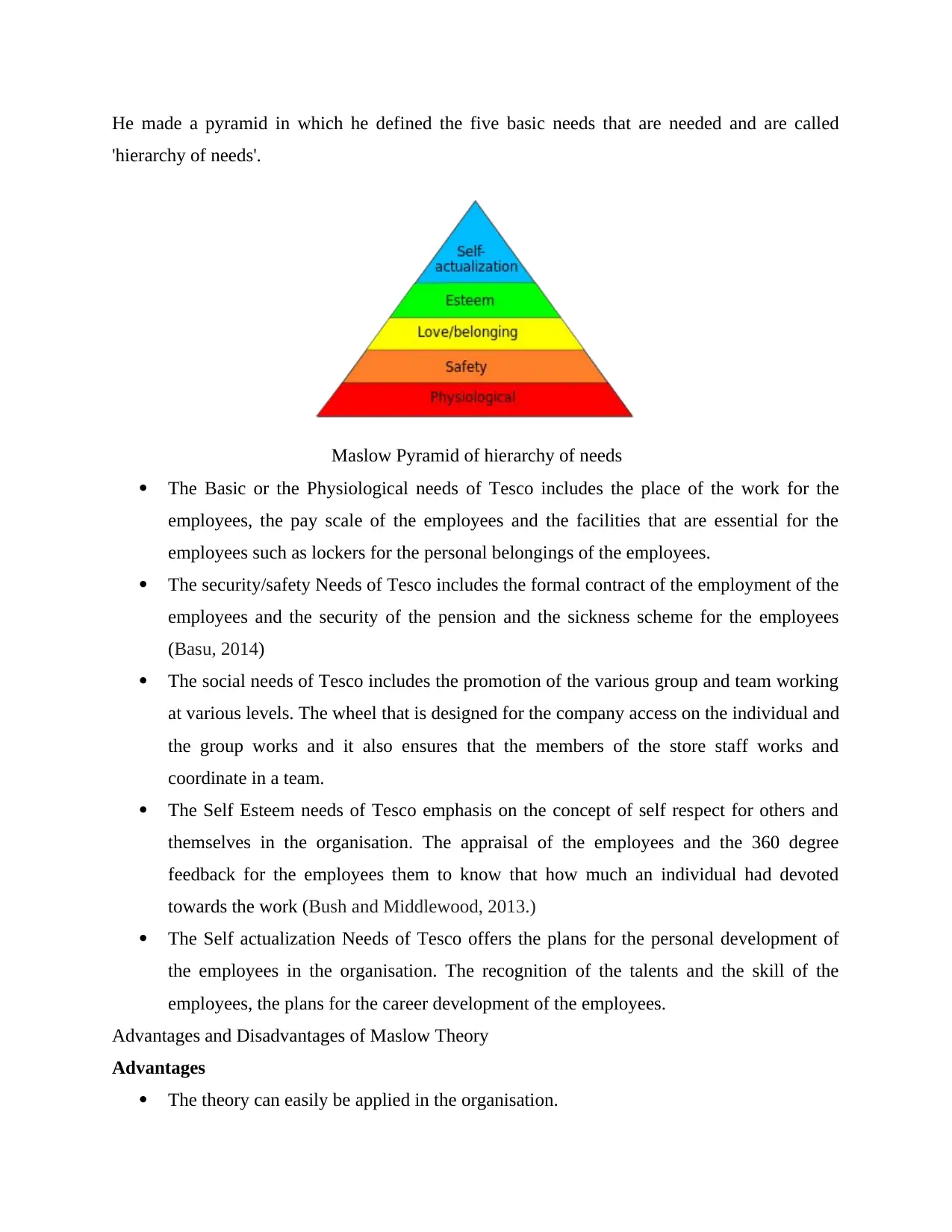
He made a pyramid in which he defined the five basic needs that are needed and are called
'hierarchy of needs'.
Maslow Pyramid of hierarchy of needs
The Basic or the Physiological needs of Tesco includes the place of the work for the
employees, the pay scale of the employees and the facilities that are essential for the
employees such as lockers for the personal belongings of the employees.
The security/safety Needs of Tesco includes the formal contract of the employment of the
employees and the security of the pension and the sickness scheme for the employees
(Basu, 2014)
The social needs of Tesco includes the promotion of the various group and team working
at various levels. The wheel that is designed for the company access on the individual and
the group works and it also ensures that the members of the store staff works and
coordinate in a team.
The Self Esteem needs of Tesco emphasis on the concept of self respect for others and
themselves in the organisation. The appraisal of the employees and the 360 degree
feedback for the employees them to know that how much an individual had devoted
towards the work (Bush and Middlewood, 2013.)
The Self actualization Needs of Tesco offers the plans for the personal development of
the employees in the organisation. The recognition of the talents and the skill of the
employees, the plans for the career development of the employees.
Advantages and Disadvantages of Maslow Theory
Advantages
The theory can easily be applied in the organisation.
'hierarchy of needs'.
Maslow Pyramid of hierarchy of needs
The Basic or the Physiological needs of Tesco includes the place of the work for the
employees, the pay scale of the employees and the facilities that are essential for the
employees such as lockers for the personal belongings of the employees.
The security/safety Needs of Tesco includes the formal contract of the employment of the
employees and the security of the pension and the sickness scheme for the employees
(Basu, 2014)
The social needs of Tesco includes the promotion of the various group and team working
at various levels. The wheel that is designed for the company access on the individual and
the group works and it also ensures that the members of the store staff works and
coordinate in a team.
The Self Esteem needs of Tesco emphasis on the concept of self respect for others and
themselves in the organisation. The appraisal of the employees and the 360 degree
feedback for the employees them to know that how much an individual had devoted
towards the work (Bush and Middlewood, 2013.)
The Self actualization Needs of Tesco offers the plans for the personal development of
the employees in the organisation. The recognition of the talents and the skill of the
employees, the plans for the career development of the employees.
Advantages and Disadvantages of Maslow Theory
Advantages
The theory can easily be applied in the organisation.
Paraphrase This Document
Need a fresh take? Get an instant paraphrase of this document with our AI Paraphraser
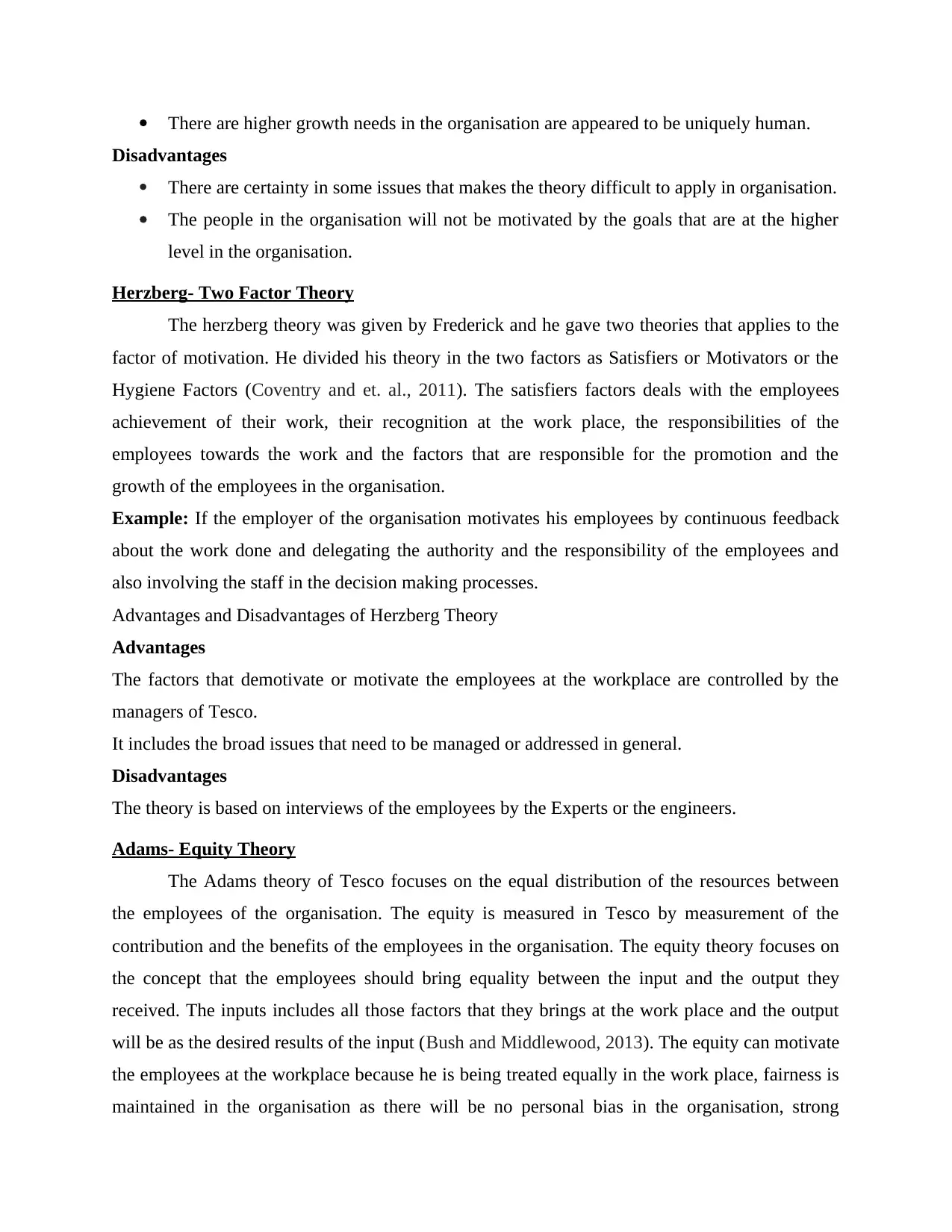
There are higher growth needs in the organisation are appeared to be uniquely human.
Disadvantages
There are certainty in some issues that makes the theory difficult to apply in organisation.
The people in the organisation will not be motivated by the goals that are at the higher
level in the organisation.
Herzberg- Two Factor Theory
The herzberg theory was given by Frederick and he gave two theories that applies to the
factor of motivation. He divided his theory in the two factors as Satisfiers or Motivators or the
Hygiene Factors (Coventry and et. al., 2011). The satisfiers factors deals with the employees
achievement of their work, their recognition at the work place, the responsibilities of the
employees towards the work and the factors that are responsible for the promotion and the
growth of the employees in the organisation.
Example: If the employer of the organisation motivates his employees by continuous feedback
about the work done and delegating the authority and the responsibility of the employees and
also involving the staff in the decision making processes.
Advantages and Disadvantages of Herzberg Theory
Advantages
The factors that demotivate or motivate the employees at the workplace are controlled by the
managers of Tesco.
It includes the broad issues that need to be managed or addressed in general.
Disadvantages
The theory is based on interviews of the employees by the Experts or the engineers.
Adams- Equity Theory
The Adams theory of Tesco focuses on the equal distribution of the resources between
the employees of the organisation. The equity is measured in Tesco by measurement of the
contribution and the benefits of the employees in the organisation. The equity theory focuses on
the concept that the employees should bring equality between the input and the output they
received. The inputs includes all those factors that they brings at the work place and the output
will be as the desired results of the input (Bush and Middlewood, 2013). The equity can motivate
the employees at the workplace because he is being treated equally in the work place, fairness is
maintained in the organisation as there will be no personal bias in the organisation, strong
Disadvantages
There are certainty in some issues that makes the theory difficult to apply in organisation.
The people in the organisation will not be motivated by the goals that are at the higher
level in the organisation.
Herzberg- Two Factor Theory
The herzberg theory was given by Frederick and he gave two theories that applies to the
factor of motivation. He divided his theory in the two factors as Satisfiers or Motivators or the
Hygiene Factors (Coventry and et. al., 2011). The satisfiers factors deals with the employees
achievement of their work, their recognition at the work place, the responsibilities of the
employees towards the work and the factors that are responsible for the promotion and the
growth of the employees in the organisation.
Example: If the employer of the organisation motivates his employees by continuous feedback
about the work done and delegating the authority and the responsibility of the employees and
also involving the staff in the decision making processes.
Advantages and Disadvantages of Herzberg Theory
Advantages
The factors that demotivate or motivate the employees at the workplace are controlled by the
managers of Tesco.
It includes the broad issues that need to be managed or addressed in general.
Disadvantages
The theory is based on interviews of the employees by the Experts or the engineers.
Adams- Equity Theory
The Adams theory of Tesco focuses on the equal distribution of the resources between
the employees of the organisation. The equity is measured in Tesco by measurement of the
contribution and the benefits of the employees in the organisation. The equity theory focuses on
the concept that the employees should bring equality between the input and the output they
received. The inputs includes all those factors that they brings at the work place and the output
will be as the desired results of the input (Bush and Middlewood, 2013). The equity can motivate
the employees at the workplace because he is being treated equally in the work place, fairness is
maintained in the organisation as there will be no personal bias in the organisation, strong
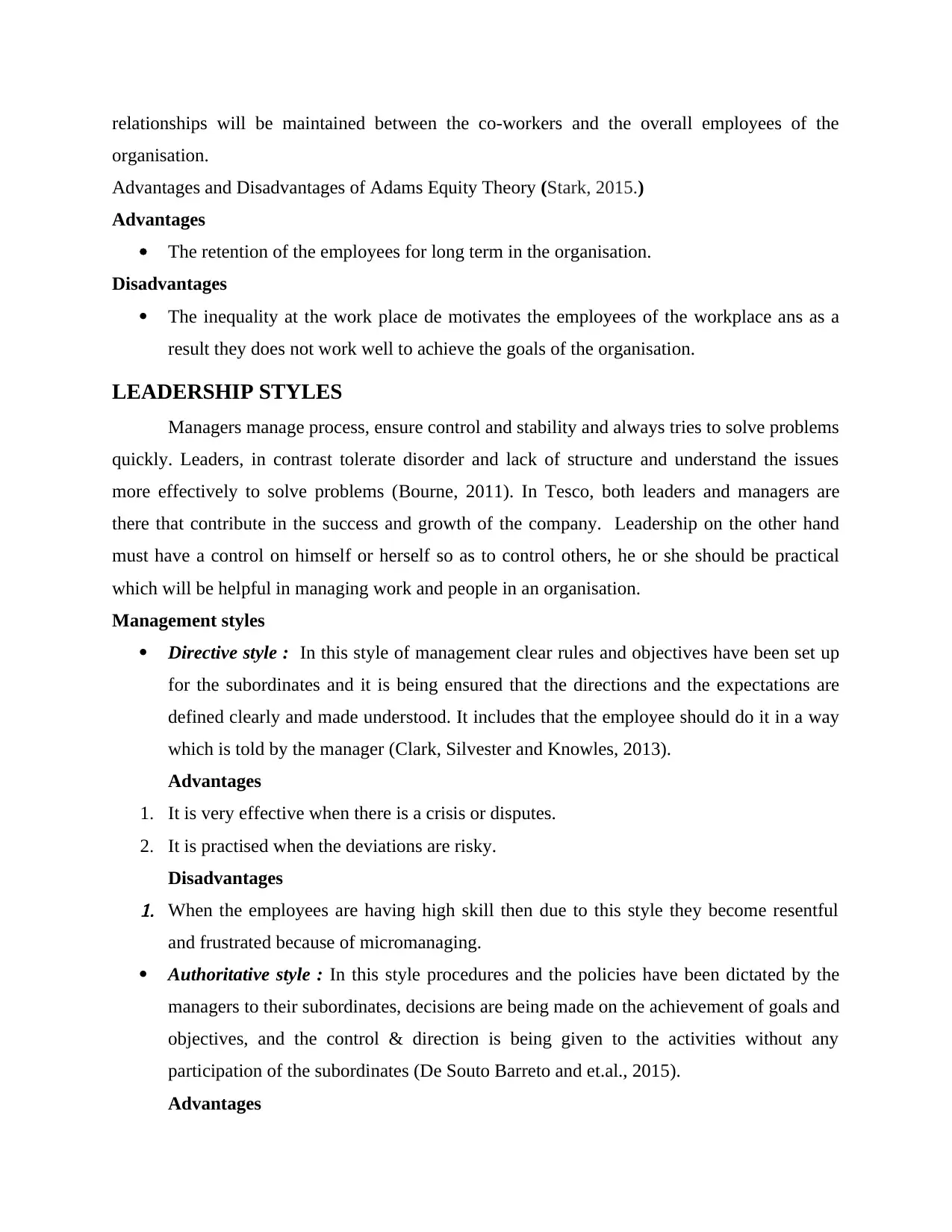
relationships will be maintained between the co-workers and the overall employees of the
organisation.
Advantages and Disadvantages of Adams Equity Theory (Stark, 2015.)
Advantages
The retention of the employees for long term in the organisation.
Disadvantages
The inequality at the work place de motivates the employees of the workplace ans as a
result they does not work well to achieve the goals of the organisation.
LEADERSHIP STYLES
Managers manage process, ensure control and stability and always tries to solve problems
quickly. Leaders, in contrast tolerate disorder and lack of structure and understand the issues
more effectively to solve problems (Bourne, 2011). In Tesco, both leaders and managers are
there that contribute in the success and growth of the company. Leadership on the other hand
must have a control on himself or herself so as to control others, he or she should be practical
which will be helpful in managing work and people in an organisation.
Management styles
Directive style : In this style of management clear rules and objectives have been set up
for the subordinates and it is being ensured that the directions and the expectations are
defined clearly and made understood. It includes that the employee should do it in a way
which is told by the manager (Clark, Silvester and Knowles, 2013).
Advantages
1. It is very effective when there is a crisis or disputes.
2. It is practised when the deviations are risky.
Disadvantages1. When the employees are having high skill then due to this style they become resentful
and frustrated because of micromanaging.
Authoritative style : In this style procedures and the policies have been dictated by the
managers to their subordinates, decisions are being made on the achievement of goals and
objectives, and the control & direction is being given to the activities without any
participation of the subordinates (De Souto Barreto and et.al., 2015).
Advantages
organisation.
Advantages and Disadvantages of Adams Equity Theory (Stark, 2015.)
Advantages
The retention of the employees for long term in the organisation.
Disadvantages
The inequality at the work place de motivates the employees of the workplace ans as a
result they does not work well to achieve the goals of the organisation.
LEADERSHIP STYLES
Managers manage process, ensure control and stability and always tries to solve problems
quickly. Leaders, in contrast tolerate disorder and lack of structure and understand the issues
more effectively to solve problems (Bourne, 2011). In Tesco, both leaders and managers are
there that contribute in the success and growth of the company. Leadership on the other hand
must have a control on himself or herself so as to control others, he or she should be practical
which will be helpful in managing work and people in an organisation.
Management styles
Directive style : In this style of management clear rules and objectives have been set up
for the subordinates and it is being ensured that the directions and the expectations are
defined clearly and made understood. It includes that the employee should do it in a way
which is told by the manager (Clark, Silvester and Knowles, 2013).
Advantages
1. It is very effective when there is a crisis or disputes.
2. It is practised when the deviations are risky.
Disadvantages1. When the employees are having high skill then due to this style they become resentful
and frustrated because of micromanaging.
Authoritative style : In this style procedures and the policies have been dictated by the
managers to their subordinates, decisions are being made on the achievement of goals and
objectives, and the control & direction is being given to the activities without any
participation of the subordinates (De Souto Barreto and et.al., 2015).
Advantages
⊘ This is a preview!⊘
Do you want full access?
Subscribe today to unlock all pages.

Trusted by 1+ million students worldwide
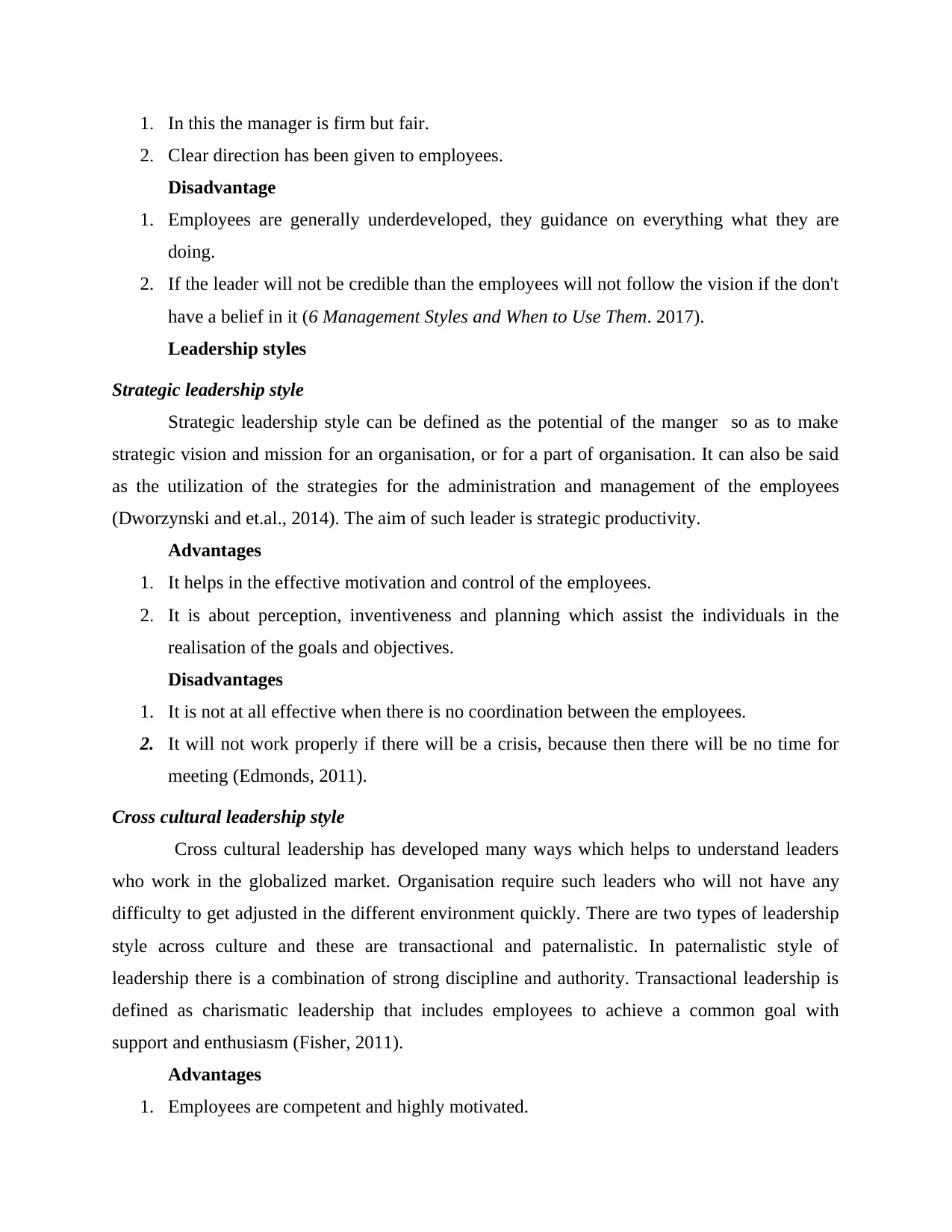
1. In this the manager is firm but fair.
2. Clear direction has been given to employees.
Disadvantage
1. Employees are generally underdeveloped, they guidance on everything what they are
doing.
2. If the leader will not be credible than the employees will not follow the vision if the don't
have a belief in it (6 Management Styles and When to Use Them. 2017).
Leadership styles
Strategic leadership style
Strategic leadership style can be defined as the potential of the manger so as to make
strategic vision and mission for an organisation, or for a part of organisation. It can also be said
as the utilization of the strategies for the administration and management of the employees
(Dworzynski and et.al., 2014). The aim of such leader is strategic productivity.
Advantages
1. It helps in the effective motivation and control of the employees.
2. It is about perception, inventiveness and planning which assist the individuals in the
realisation of the goals and objectives.
Disadvantages
1. It is not at all effective when there is no coordination between the employees.
2. It will not work properly if there will be a crisis, because then there will be no time for
meeting (Edmonds, 2011).
Cross cultural leadership style
Cross cultural leadership has developed many ways which helps to understand leaders
who work in the globalized market. Organisation require such leaders who will not have any
difficulty to get adjusted in the different environment quickly. There are two types of leadership
style across culture and these are transactional and paternalistic. In paternalistic style of
leadership there is a combination of strong discipline and authority. Transactional leadership is
defined as charismatic leadership that includes employees to achieve a common goal with
support and enthusiasm (Fisher, 2011).
Advantages
1. Employees are competent and highly motivated.
2. Clear direction has been given to employees.
Disadvantage
1. Employees are generally underdeveloped, they guidance on everything what they are
doing.
2. If the leader will not be credible than the employees will not follow the vision if the don't
have a belief in it (6 Management Styles and When to Use Them. 2017).
Leadership styles
Strategic leadership style
Strategic leadership style can be defined as the potential of the manger so as to make
strategic vision and mission for an organisation, or for a part of organisation. It can also be said
as the utilization of the strategies for the administration and management of the employees
(Dworzynski and et.al., 2014). The aim of such leader is strategic productivity.
Advantages
1. It helps in the effective motivation and control of the employees.
2. It is about perception, inventiveness and planning which assist the individuals in the
realisation of the goals and objectives.
Disadvantages
1. It is not at all effective when there is no coordination between the employees.
2. It will not work properly if there will be a crisis, because then there will be no time for
meeting (Edmonds, 2011).
Cross cultural leadership style
Cross cultural leadership has developed many ways which helps to understand leaders
who work in the globalized market. Organisation require such leaders who will not have any
difficulty to get adjusted in the different environment quickly. There are two types of leadership
style across culture and these are transactional and paternalistic. In paternalistic style of
leadership there is a combination of strong discipline and authority. Transactional leadership is
defined as charismatic leadership that includes employees to achieve a common goal with
support and enthusiasm (Fisher, 2011).
Advantages
1. Employees are competent and highly motivated.
Paraphrase This Document
Need a fresh take? Get an instant paraphrase of this document with our AI Paraphraser
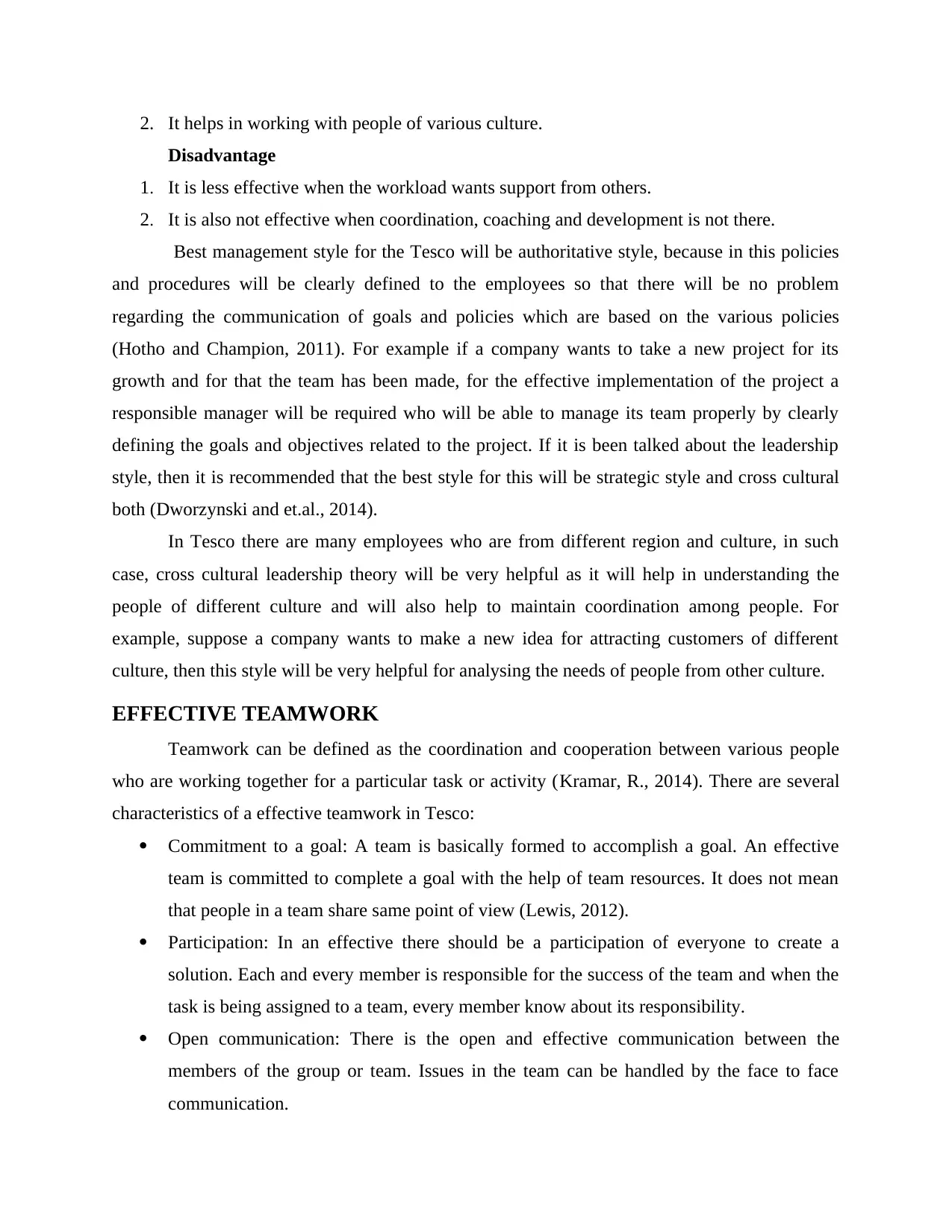
2. It helps in working with people of various culture.
Disadvantage
1. It is less effective when the workload wants support from others.
2. It is also not effective when coordination, coaching and development is not there.
Best management style for the Tesco will be authoritative style, because in this policies
and procedures will be clearly defined to the employees so that there will be no problem
regarding the communication of goals and policies which are based on the various policies
(Hotho and Champion, 2011). For example if a company wants to take a new project for its
growth and for that the team has been made, for the effective implementation of the project a
responsible manager will be required who will be able to manage its team properly by clearly
defining the goals and objectives related to the project. If it is been talked about the leadership
style, then it is recommended that the best style for this will be strategic style and cross cultural
both (Dworzynski and et.al., 2014).
In Tesco there are many employees who are from different region and culture, in such
case, cross cultural leadership theory will be very helpful as it will help in understanding the
people of different culture and will also help to maintain coordination among people. For
example, suppose a company wants to make a new idea for attracting customers of different
culture, then this style will be very helpful for analysing the needs of people from other culture.
EFFECTIVE TEAMWORK
Teamwork can be defined as the coordination and cooperation between various people
who are working together for a particular task or activity (Kramar, R., 2014). There are several
characteristics of a effective teamwork in Tesco:
Commitment to a goal: A team is basically formed to accomplish a goal. An effective
team is committed to complete a goal with the help of team resources. It does not mean
that people in a team share same point of view (Lewis, 2012).
Participation: In an effective there should be a participation of everyone to create a
solution. Each and every member is responsible for the success of the team and when the
task is being assigned to a team, every member know about its responsibility.
Open communication: There is the open and effective communication between the
members of the group or team. Issues in the team can be handled by the face to face
communication.
Disadvantage
1. It is less effective when the workload wants support from others.
2. It is also not effective when coordination, coaching and development is not there.
Best management style for the Tesco will be authoritative style, because in this policies
and procedures will be clearly defined to the employees so that there will be no problem
regarding the communication of goals and policies which are based on the various policies
(Hotho and Champion, 2011). For example if a company wants to take a new project for its
growth and for that the team has been made, for the effective implementation of the project a
responsible manager will be required who will be able to manage its team properly by clearly
defining the goals and objectives related to the project. If it is been talked about the leadership
style, then it is recommended that the best style for this will be strategic style and cross cultural
both (Dworzynski and et.al., 2014).
In Tesco there are many employees who are from different region and culture, in such
case, cross cultural leadership theory will be very helpful as it will help in understanding the
people of different culture and will also help to maintain coordination among people. For
example, suppose a company wants to make a new idea for attracting customers of different
culture, then this style will be very helpful for analysing the needs of people from other culture.
EFFECTIVE TEAMWORK
Teamwork can be defined as the coordination and cooperation between various people
who are working together for a particular task or activity (Kramar, R., 2014). There are several
characteristics of a effective teamwork in Tesco:
Commitment to a goal: A team is basically formed to accomplish a goal. An effective
team is committed to complete a goal with the help of team resources. It does not mean
that people in a team share same point of view (Lewis, 2012).
Participation: In an effective there should be a participation of everyone to create a
solution. Each and every member is responsible for the success of the team and when the
task is being assigned to a team, every member know about its responsibility.
Open communication: There is the open and effective communication between the
members of the group or team. Issues in the team can be handled by the face to face
communication.
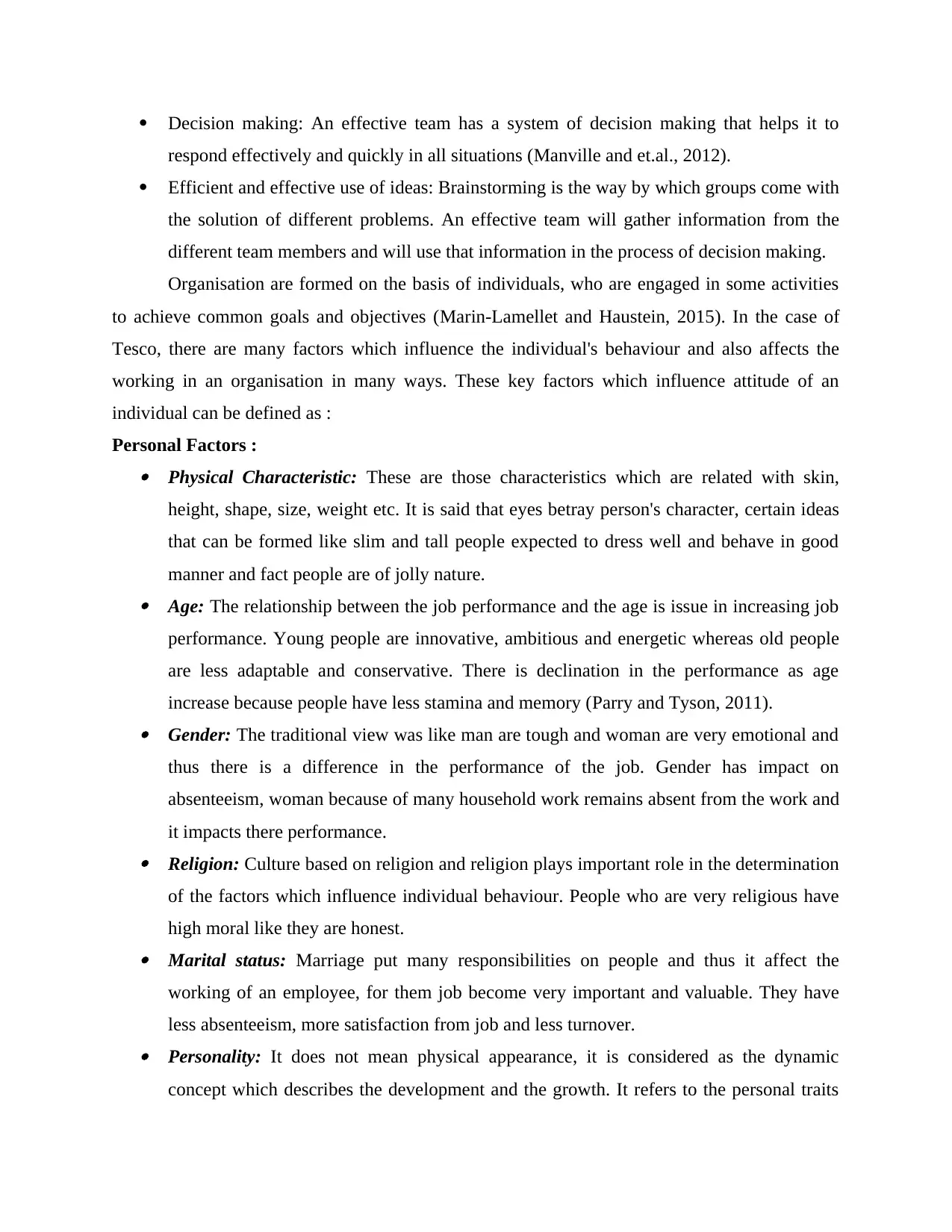
Decision making: An effective team has a system of decision making that helps it to
respond effectively and quickly in all situations (Manville and et.al., 2012).
Efficient and effective use of ideas: Brainstorming is the way by which groups come with
the solution of different problems. An effective team will gather information from the
different team members and will use that information in the process of decision making.
Organisation are formed on the basis of individuals, who are engaged in some activities
to achieve common goals and objectives (Marin-Lamellet and Haustein, 2015). In the case of
Tesco, there are many factors which influence the individual's behaviour and also affects the
working in an organisation in many ways. These key factors which influence attitude of an
individual can be defined as :
Personal Factors : Physical Characteristic: These are those characteristics which are related with skin,
height, shape, size, weight etc. It is said that eyes betray person's character, certain ideas
that can be formed like slim and tall people expected to dress well and behave in good
manner and fact people are of jolly nature. Age: The relationship between the job performance and the age is issue in increasing job
performance. Young people are innovative, ambitious and energetic whereas old people
are less adaptable and conservative. There is declination in the performance as age
increase because people have less stamina and memory (Parry and Tyson, 2011). Gender: The traditional view was like man are tough and woman are very emotional and
thus there is a difference in the performance of the job. Gender has impact on
absenteeism, woman because of many household work remains absent from the work and
it impacts there performance. Religion: Culture based on religion and religion plays important role in the determination
of the factors which influence individual behaviour. People who are very religious have
high moral like they are honest. Marital status: Marriage put many responsibilities on people and thus it affect the
working of an employee, for them job become very important and valuable. They have
less absenteeism, more satisfaction from job and less turnover. Personality: It does not mean physical appearance, it is considered as the dynamic
concept which describes the development and the growth. It refers to the personal traits
respond effectively and quickly in all situations (Manville and et.al., 2012).
Efficient and effective use of ideas: Brainstorming is the way by which groups come with
the solution of different problems. An effective team will gather information from the
different team members and will use that information in the process of decision making.
Organisation are formed on the basis of individuals, who are engaged in some activities
to achieve common goals and objectives (Marin-Lamellet and Haustein, 2015). In the case of
Tesco, there are many factors which influence the individual's behaviour and also affects the
working in an organisation in many ways. These key factors which influence attitude of an
individual can be defined as :
Personal Factors : Physical Characteristic: These are those characteristics which are related with skin,
height, shape, size, weight etc. It is said that eyes betray person's character, certain ideas
that can be formed like slim and tall people expected to dress well and behave in good
manner and fact people are of jolly nature. Age: The relationship between the job performance and the age is issue in increasing job
performance. Young people are innovative, ambitious and energetic whereas old people
are less adaptable and conservative. There is declination in the performance as age
increase because people have less stamina and memory (Parry and Tyson, 2011). Gender: The traditional view was like man are tough and woman are very emotional and
thus there is a difference in the performance of the job. Gender has impact on
absenteeism, woman because of many household work remains absent from the work and
it impacts there performance. Religion: Culture based on religion and religion plays important role in the determination
of the factors which influence individual behaviour. People who are very religious have
high moral like they are honest. Marital status: Marriage put many responsibilities on people and thus it affect the
working of an employee, for them job become very important and valuable. They have
less absenteeism, more satisfaction from job and less turnover. Personality: It does not mean physical appearance, it is considered as the dynamic
concept which describes the development and the growth. It refers to the personal traits
⊘ This is a preview!⊘
Do you want full access?
Subscribe today to unlock all pages.

Trusted by 1+ million students worldwide
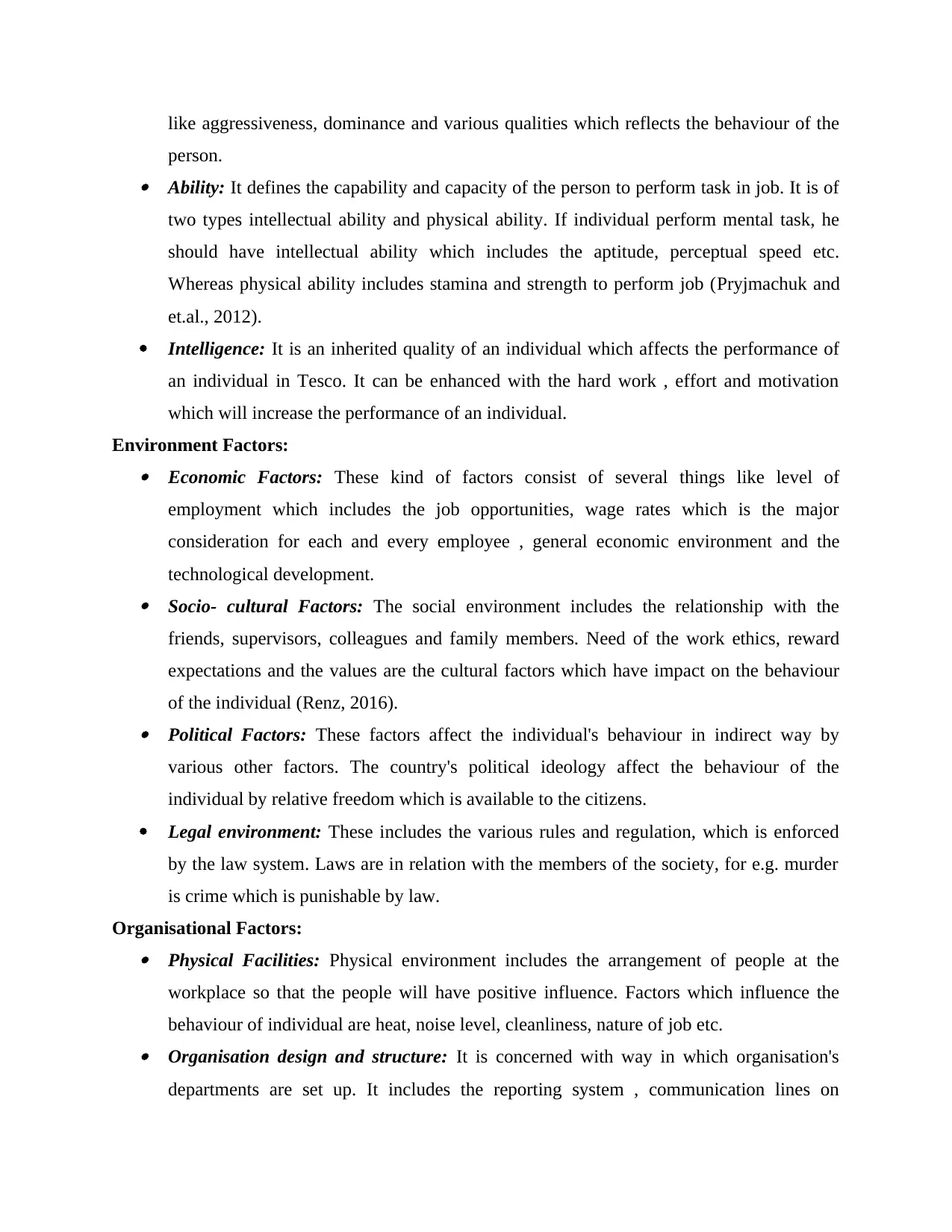
like aggressiveness, dominance and various qualities which reflects the behaviour of the
person. Ability: It defines the capability and capacity of the person to perform task in job. It is of
two types intellectual ability and physical ability. If individual perform mental task, he
should have intellectual ability which includes the aptitude, perceptual speed etc.
Whereas physical ability includes stamina and strength to perform job (Pryjmachuk and
et.al., 2012).
Intelligence: It is an inherited quality of an individual which affects the performance of
an individual in Tesco. It can be enhanced with the hard work , effort and motivation
which will increase the performance of an individual.
Environment Factors: Economic Factors: These kind of factors consist of several things like level of
employment which includes the job opportunities, wage rates which is the major
consideration for each and every employee , general economic environment and the
technological development. Socio- cultural Factors: The social environment includes the relationship with the
friends, supervisors, colleagues and family members. Need of the work ethics, reward
expectations and the values are the cultural factors which have impact on the behaviour
of the individual (Renz, 2016). Political Factors: These factors affect the individual's behaviour in indirect way by
various other factors. The country's political ideology affect the behaviour of the
individual by relative freedom which is available to the citizens.
Legal environment: These includes the various rules and regulation, which is enforced
by the law system. Laws are in relation with the members of the society, for e.g. murder
is crime which is punishable by law.
Organisational Factors: Physical Facilities: Physical environment includes the arrangement of people at the
workplace so that the people will have positive influence. Factors which influence the
behaviour of individual are heat, noise level, cleanliness, nature of job etc. Organisation design and structure: It is concerned with way in which organisation's
departments are set up. It includes the reporting system , communication lines on
person. Ability: It defines the capability and capacity of the person to perform task in job. It is of
two types intellectual ability and physical ability. If individual perform mental task, he
should have intellectual ability which includes the aptitude, perceptual speed etc.
Whereas physical ability includes stamina and strength to perform job (Pryjmachuk and
et.al., 2012).
Intelligence: It is an inherited quality of an individual which affects the performance of
an individual in Tesco. It can be enhanced with the hard work , effort and motivation
which will increase the performance of an individual.
Environment Factors: Economic Factors: These kind of factors consist of several things like level of
employment which includes the job opportunities, wage rates which is the major
consideration for each and every employee , general economic environment and the
technological development. Socio- cultural Factors: The social environment includes the relationship with the
friends, supervisors, colleagues and family members. Need of the work ethics, reward
expectations and the values are the cultural factors which have impact on the behaviour
of the individual (Renz, 2016). Political Factors: These factors affect the individual's behaviour in indirect way by
various other factors. The country's political ideology affect the behaviour of the
individual by relative freedom which is available to the citizens.
Legal environment: These includes the various rules and regulation, which is enforced
by the law system. Laws are in relation with the members of the society, for e.g. murder
is crime which is punishable by law.
Organisational Factors: Physical Facilities: Physical environment includes the arrangement of people at the
workplace so that the people will have positive influence. Factors which influence the
behaviour of individual are heat, noise level, cleanliness, nature of job etc. Organisation design and structure: It is concerned with way in which organisation's
departments are set up. It includes the reporting system , communication lines on
Paraphrase This Document
Need a fresh take? Get an instant paraphrase of this document with our AI Paraphraser
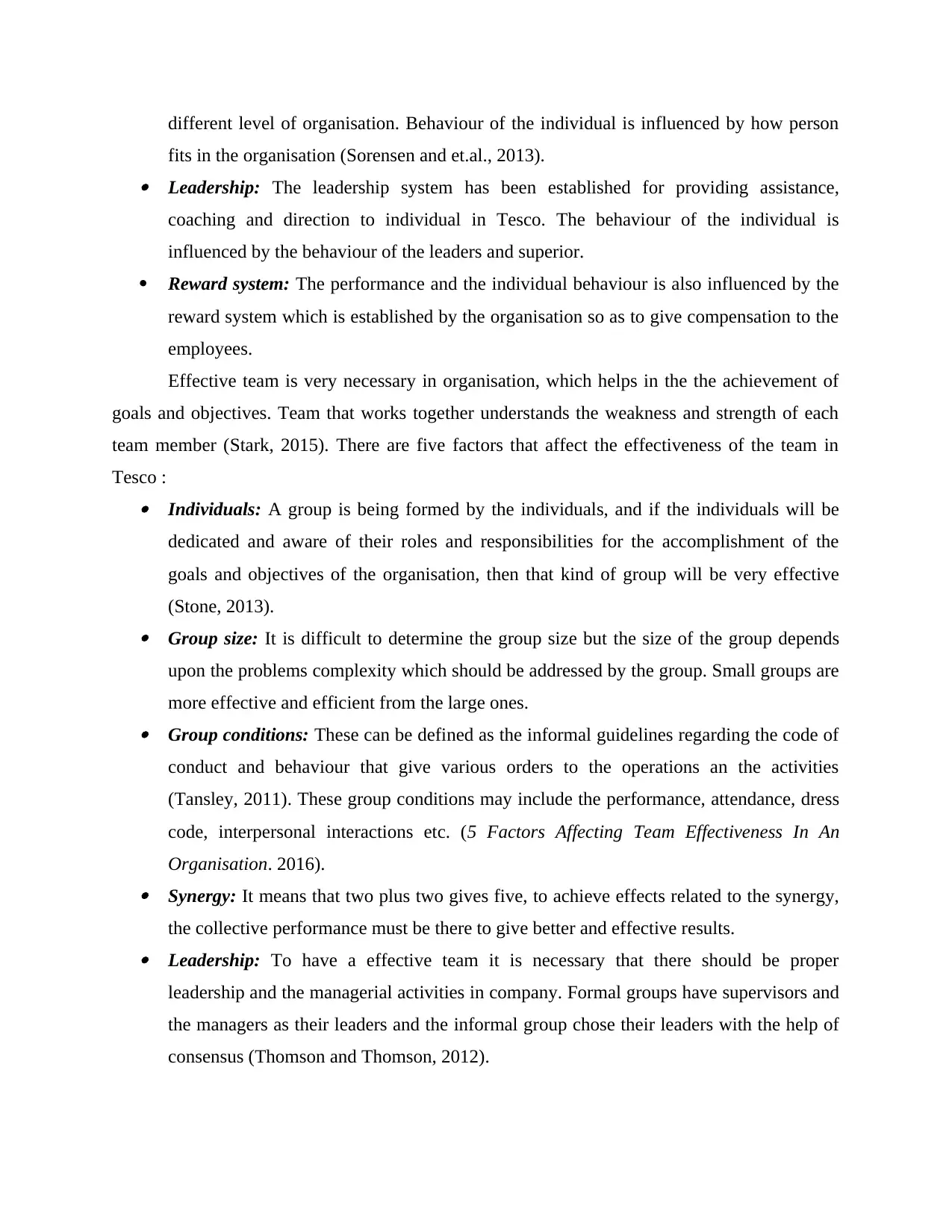
different level of organisation. Behaviour of the individual is influenced by how person
fits in the organisation (Sorensen and et.al., 2013). Leadership: The leadership system has been established for providing assistance,
coaching and direction to individual in Tesco. The behaviour of the individual is
influenced by the behaviour of the leaders and superior.
Reward system: The performance and the individual behaviour is also influenced by the
reward system which is established by the organisation so as to give compensation to the
employees.
Effective team is very necessary in organisation, which helps in the the achievement of
goals and objectives. Team that works together understands the weakness and strength of each
team member (Stark, 2015). There are five factors that affect the effectiveness of the team in
Tesco : Individuals: A group is being formed by the individuals, and if the individuals will be
dedicated and aware of their roles and responsibilities for the accomplishment of the
goals and objectives of the organisation, then that kind of group will be very effective
(Stone, 2013). Group size: It is difficult to determine the group size but the size of the group depends
upon the problems complexity which should be addressed by the group. Small groups are
more effective and efficient from the large ones. Group conditions: These can be defined as the informal guidelines regarding the code of
conduct and behaviour that give various orders to the operations an the activities
(Tansley, 2011). These group conditions may include the performance, attendance, dress
code, interpersonal interactions etc. (5 Factors Affecting Team Effectiveness In An
Organisation. 2016). Synergy: It means that two plus two gives five, to achieve effects related to the synergy,
the collective performance must be there to give better and effective results. Leadership: To have a effective team it is necessary that there should be proper
leadership and the managerial activities in company. Formal groups have supervisors and
the managers as their leaders and the informal group chose their leaders with the help of
consensus (Thomson and Thomson, 2012).
fits in the organisation (Sorensen and et.al., 2013). Leadership: The leadership system has been established for providing assistance,
coaching and direction to individual in Tesco. The behaviour of the individual is
influenced by the behaviour of the leaders and superior.
Reward system: The performance and the individual behaviour is also influenced by the
reward system which is established by the organisation so as to give compensation to the
employees.
Effective team is very necessary in organisation, which helps in the the achievement of
goals and objectives. Team that works together understands the weakness and strength of each
team member (Stark, 2015). There are five factors that affect the effectiveness of the team in
Tesco : Individuals: A group is being formed by the individuals, and if the individuals will be
dedicated and aware of their roles and responsibilities for the accomplishment of the
goals and objectives of the organisation, then that kind of group will be very effective
(Stone, 2013). Group size: It is difficult to determine the group size but the size of the group depends
upon the problems complexity which should be addressed by the group. Small groups are
more effective and efficient from the large ones. Group conditions: These can be defined as the informal guidelines regarding the code of
conduct and behaviour that give various orders to the operations an the activities
(Tansley, 2011). These group conditions may include the performance, attendance, dress
code, interpersonal interactions etc. (5 Factors Affecting Team Effectiveness In An
Organisation. 2016). Synergy: It means that two plus two gives five, to achieve effects related to the synergy,
the collective performance must be there to give better and effective results. Leadership: To have a effective team it is necessary that there should be proper
leadership and the managerial activities in company. Formal groups have supervisors and
the managers as their leaders and the informal group chose their leaders with the help of
consensus (Thomson and Thomson, 2012).
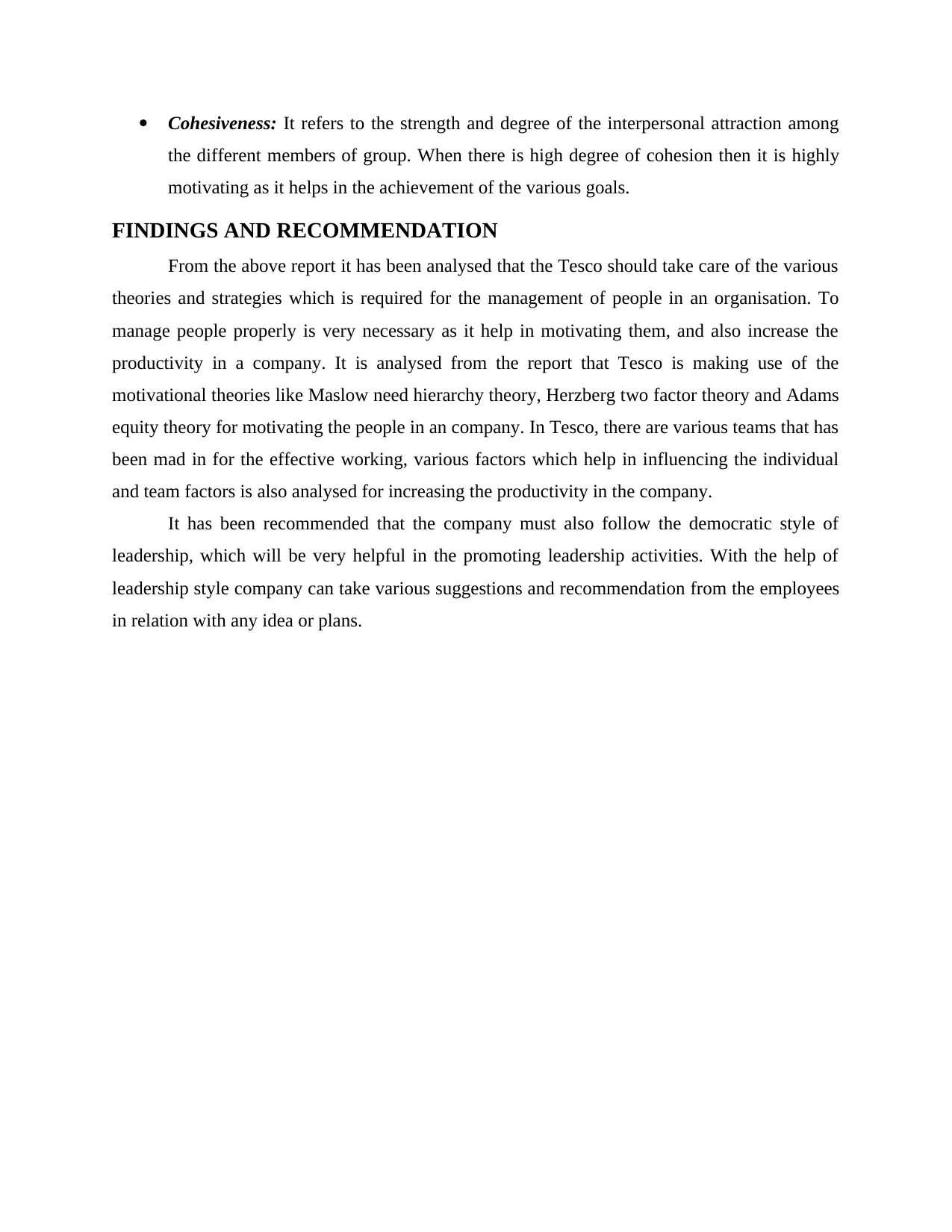
Cohesiveness: It refers to the strength and degree of the interpersonal attraction among
the different members of group. When there is high degree of cohesion then it is highly
motivating as it helps in the achievement of the various goals.
FINDINGS AND RECOMMENDATION
From the above report it has been analysed that the Tesco should take care of the various
theories and strategies which is required for the management of people in an organisation. To
manage people properly is very necessary as it help in motivating them, and also increase the
productivity in a company. It is analysed from the report that Tesco is making use of the
motivational theories like Maslow need hierarchy theory, Herzberg two factor theory and Adams
equity theory for motivating the people in an company. In Tesco, there are various teams that has
been mad in for the effective working, various factors which help in influencing the individual
and team factors is also analysed for increasing the productivity in the company.
It has been recommended that the company must also follow the democratic style of
leadership, which will be very helpful in the promoting leadership activities. With the help of
leadership style company can take various suggestions and recommendation from the employees
in relation with any idea or plans.
the different members of group. When there is high degree of cohesion then it is highly
motivating as it helps in the achievement of the various goals.
FINDINGS AND RECOMMENDATION
From the above report it has been analysed that the Tesco should take care of the various
theories and strategies which is required for the management of people in an organisation. To
manage people properly is very necessary as it help in motivating them, and also increase the
productivity in a company. It is analysed from the report that Tesco is making use of the
motivational theories like Maslow need hierarchy theory, Herzberg two factor theory and Adams
equity theory for motivating the people in an company. In Tesco, there are various teams that has
been mad in for the effective working, various factors which help in influencing the individual
and team factors is also analysed for increasing the productivity in the company.
It has been recommended that the company must also follow the democratic style of
leadership, which will be very helpful in the promoting leadership activities. With the help of
leadership style company can take various suggestions and recommendation from the employees
in relation with any idea or plans.
⊘ This is a preview!⊘
Do you want full access?
Subscribe today to unlock all pages.

Trusted by 1+ million students worldwide
1 out of 15
Related Documents
Your All-in-One AI-Powered Toolkit for Academic Success.
+13062052269
info@desklib.com
Available 24*7 on WhatsApp / Email
![[object Object]](/_next/static/media/star-bottom.7253800d.svg)
Unlock your academic potential
Copyright © 2020–2025 A2Z Services. All Rights Reserved. Developed and managed by ZUCOL.





